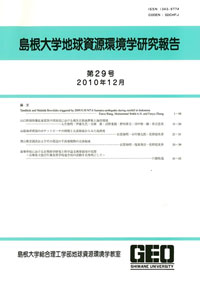島根大学総合理工学部地球資源環境学教室
ISSN:1343-9774

number of downloads : ?
Use this link to cite this item : https://ir.lib.shimane-u.ac.jp/7324
Geoscience reports of Shimane University 27
2008-12-25 発行
Major and trace element analyses of sandstones and mudstones from the Siwalik Group, Bakiya Khola, central Nepal
Ulak, Prakash Das
Barry, Roser
Hossain, H.M.Zakir
File
Description
This report contains whole-rock major and trace element analyses of 206 Middle Miocene to Pleistocene sandstones and mudstones from the Siwalik Group in the Bakiya Khola area of Central Nepal, as part of a continuing study of their geochemistry. Data are presented for the Rapti (n=85), Amlekhganj (n=90), Churia Khola (n=10) and Churia Mai Formations (n=21). All were analyzed by X-ray fluorescence for the major elements and 18 trace elements. Lithotype averages for each formation show SiO2 contents generally increase up section, whereas all other major elements decrease. CaO abundances are enriched in the Rapti and Amlekhganj suites. Trace element averages also fall up section in response to the increase in SiO2. Average trace element contents in the mudstones of each formation are generally higher than in their companion sandstones, suggesting the proportion of clay minerals present controls their abundances. Zirconium is an exception, reflecting zircon concentration in the sandstones. Normalization against average upper continental crust (UCC) shows most elements are present at crustal levels, especially in the sandstones. However, Na2O, Sr and to a lesser extent CaO are strongly depleted, whereas Zr, Th, Ce, Y are enriched relative to UCC. Ferromagnesian elements (Sc, Fe, Ti, Ni, Cr, V) are also enriched in the mudstones relative to UCC. The causes of these anomalies will be examined in future work.
Other Article
